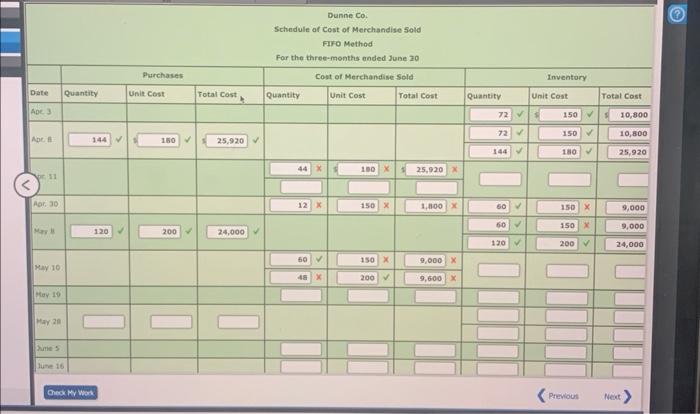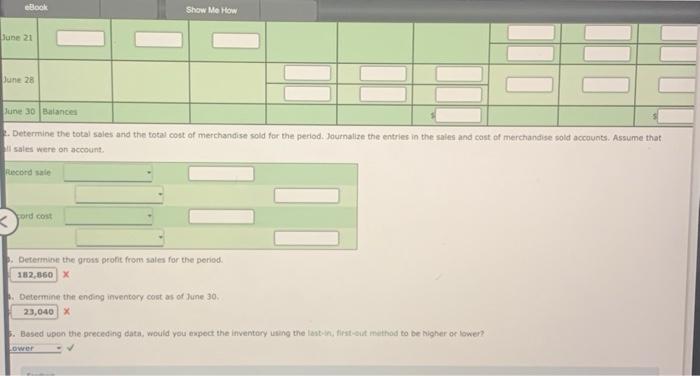Question
Show Me How Question Content Area LIFO Perpetual Inventory The beginning inventory of merchandise at Dunne Co. and data on purchases and sales for a
- Show Me How
Question Content Area
LIFOPerpetual Inventory
The beginning inventory of merchandise at Dunne Co. and data on purchases and sales for a three-month period ending June 30 are as follows:
| Date | Transaction | Number of Units | Per Unit | Total | ||||
|---|---|---|---|---|---|---|---|---|
| Apr. 3 | Inventory | 42 | $450 | $18,900 | ||||
| 8 | Purchase | 84 | 540 | 45,360 | ||||
| 11 | Sale | 56 | 1,500 | 84,000 | ||||
| 30 | Sale | 35 | 1,500 | 52,500 | ||||
| May 8 | Purchase | 70 | 600 | 42,000 | ||||
| 10 | Sale | 42 | 1,500 | 63,000 | ||||
| 19 | Sale | 21 | 1,500 | 31,500 | ||||
| 28 | Purchase | 70 | 660 | 46,200 | ||||
| June 5 | Sale | 42 | 1,575 | 66,150 | ||||
| 16 | Sale | 56 | 1,575 | 88,200 | ||||
| 21 | Purchase | 126 | 720 | 90,720 | ||||
| 28 | Sale | 63 | 1,575 | 99,225 |
Required:
1. Record the inventory, purchases, and cost of merchandise sold data in a perpetual inventory record similar to the one illustrated inExhibit 4, using the last-in, first-out method. Under LIFO, if units are in inventory at two different costs, enter the units with the HIGHER unit cost first in the Cost of Merchandise Sold Unit Cost column and LOWER unit cost first in the Inventory Unit Cost column.
2. Determine the total sales, the total cost of merchandise sold, and the gross profit from sales for the period.
| Total sales | $fill in the blank 114 |
| Total cost of merchandise sold | fill in the blank 115 |
| Gross profit | $fill in the blank 116 |
3. Determine the ending inventory cost on June 30. $fill in the blank 117
FIFOPerpetual Inventory
The beginning inventory of merchandise at Dunne Co. and data on purchases and sales for a three-month period ending June 30 are as follows:
| Date | Transaction | Number of Units | Per Unit | Total | ||||
| Apr. 3 | Inventory | 72 | $150 | $10,800 | ||||
| 8 | Purchase | 144 | 180 | 25,920 | ||||
| 11 | Sale | 96 | 500 | 48,000 | ||||
| 30 | Sale | 60 | 500 | 30,000 | ||||
| May 8 | Purchase | 120 | 200 | 24,000 | ||||
| 10 | Sale | 72 | 500 | 36,000 | ||||
| 19 | Sale | 36 | 500 | 18,000 | ||||
| 28 | Purchase | 120 | 220 | 26,400 | ||||
| June 5 | Sale | 72 | 525 | 37,800 | ||||
| 16 | Sale | 96 | 525 | 50,400 | ||||
| 21 | Purchase | 216 | 240 | 51,840 | ||||
| 28 | Sale | 108 | 525 | 56,700 |
Required:
1. Record the inventory, purchases, and cost of merchandise sold data in a perpetual inventory record similar to the one illustrated inExhibit 3, using the first-in, first-out method. Under FIFO, if units are in inventory at two different costs, enter the units with the LOWER unit cost first in the Cost of Merchandise Sold Unit Cost column and in the Inventory Unit Cost column.


Step by Step Solution
There are 3 Steps involved in it
Step: 1

Get Instant Access to Expert-Tailored Solutions
See step-by-step solutions with expert insights and AI powered tools for academic success
Step: 2

Step: 3

Ace Your Homework with AI
Get the answers you need in no time with our AI-driven, step-by-step assistance
Get Started


